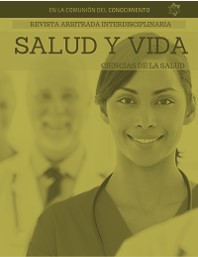Educational strategies for the early approach to prenatal control
DOI:
https://doi.org/10.35381/s.v.v6i2.2148Keywords:
Female urogenital diseases and pregnancy complications, Abortion, spontaneous, Adolescent behavior . (Source, DeCS).Abstract
Objective: To analyze educational strategies for the early approach to prenatal care in pregnant women at the "Pugacho" health center in the city of Ibarra - Ecuador. Method: Descriptive observational study. Results: 52% stated that they did not know about culturally adequate childbirth because they were foreign mothers and did not practice it in their culture, while 48% stated that they did know about culturally adequate childbirth because family members or acquaintances practiced it in their pregnancies. Conclusion: Prenatal diagnosis evaluates the need for invasive tests according to the prioritization of the risk of congenital anomalies, that is to say, it is concluded that the pregnant mother who has all the controls can prevent any type of anomalies to her baby and that is the importance of each control.
Downloads
References
Eggleston E. Unintended pregnancy and women's use of prenatal care in Ecuador. Soc Sci Med. 2000;51(7):1011-1018. doi:10.1016/s0277-9536(00)00010-1
Wade KB, Sevilla F, Labbok MH. Integrating the Lactational Amenorrhea Method into a family planning program in Ecuador. Stud Fam Plann. 1994;25(3):162-175.
Chedraui P, Van Ardenne R, Wendte JF, Quintero JC, Hidalgo L. Knowledge and practice of family planning and HIV-prevention behaviour among just delivered adolescents in Ecuador: the problem of adolescent pregnancies. Arch Gynecol Obstet. 2007;276(2):139-144. doi: 10.1007/s00404-007-0325-5
Rivera R, Solis JA. Improve family planning after pregnancy. Netw Res Triangle Park N C. 1997;17(4):4-6.
Feld H, Rojas V, Linares AM. "We keep quiet": exploring the context of pregnancy intention in a low-resource community in Ecuador. Sex Reprod Health Matters. 2019;27(1):1686198. doi:10.1080/26410397.2019.1686198
Eggleston E, Tsui AO, Kotelchuck M. Unintended pregnancy and low birthweight in Ecuador. Am J Public Health. 2001;91(5):808-810. doi:10.2105/ajph.91.5.808
Beyenburg S, Schmutzler AG. Kinderwunsch und Schwangerschaft bei Frauen mit Epilepsie [Women with epilepsy planning pregnancy]. Zentralbl Gynakol. 2004;126(3):112-118. doi:10.1055/s-2004-818778
Sedgh G, Finer LB, Bankole A, Eilers MA, Singh S. Adolescent pregnancy, birth, and abortion rates across countries: levels and recent trends. J Adolesc Health. 2015;56(2):223-230. doi:10.1016/j.jadohealth.2014.09.007
Sánchez-Gómez A, Cevallos W, Grijalva MJ, et al. Factores sociales asociados con la utilización de los servicios de atención prenatal en Ecuador [Social factors associated with use of prenatal care in Ecuador]. Rev Panam Salud Publica. 2016;40(5):341-346.
Paredes I, Hidalgo L, Chedraui P, Palma J, Eugenio J. Factors associated with inadequate prenatal care in Ecuadorian women. Int J Gynaecol Obstet. 2005;88(2):168-172. doi:10.1016/j.ijgo.2004.09.024
Dube A, Bartlett G, Morales J, et al. The Chilcapamba-McGill Partnership: Exploring Access to Maternal and Newborn Care in Indigenous Communities of Ecuador. Prog Community Health Partnersh. 2015;9(3):327-334. doi:10.1353/cpr.2015.0065
Buekens P, Hernández P, Infante C. La atención prenatal en América Latina [Prenatal care in Latin America]. Salud Publica Mex. 1990;32(6):673-684.
Jahnke JR, Houck KM, Bentley ME, Thompson AL. Rising rates of cesarean delivery in Ecuador: Socioeconomic and institutional determinants over two decades. Birth. 2019;46(2):335-343. doi:10.1111/birt.12421
Wehby GL, Pawluk M, Nyarko KA, López-Camelo JS. Explaining ethnic disparities in preterm birth in Argentina and Ecuador. Glob Public Health. 2018;13(8):1126-1143. doi:10.1080/17441692.2016.1251603
Dearborn JL, Lewis J, Mino GP. Preventing mother-to-child transmission in Guayaquil, Ecuador: HIV knowledge and risk perception. Glob Public Health. 2010;5(6):649-662. doi:10.1080/17441690903367141
Published
How to Cite
Issue
Section
License
CC BY-NC-SA : Esta licencia permite a los reutilizadores distribuir, remezclar, adaptar y construir sobre el material en cualquier medio o formato solo con fines no comerciales, y solo siempre y cuando se dé la atribución al creador. Si remezcla, adapta o construye sobre el material, debe licenciar el material modificado bajo términos idénticos.
OAI-PMH: https://fundacionkoinonia.com.ve/ojs/index.php/saludyvida/oai.









